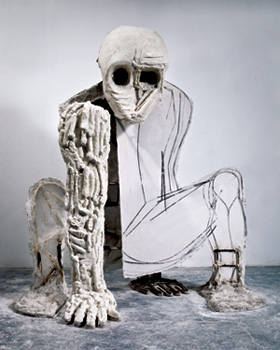
British-born, LA-based sculptor Thomas Houseago\'s work reveals an unabashed appreciation for the past, inspired by the myths of ancient Greece and the abstraction of the Modern era. Houseago interprets the human figure, and he proves to be an able contortionist--incorporating the fragmentation of Picasso, the humanity of Rodin, and the expressiveness of Giocometti while rejecting the late-modernist notion of the purity of materials with a distinct sketchbook-style DIY aesthetic that is undeniably his own.
Born in 1972 in Leeds, England, Houseago received a grant to attend a local art school in 1989, and later studied at the Central St. Martin\'s College of Art in London before attending De Ateliers in Amsterdam. After working in Brussels for a few years, he and his wife, painter Amy Bessone, moved to Los Angeles in 2004, in what he has described \"an act of desperation.\" Three years later, the move paid off when his work caught the eye of Miami-based collectors Don and Mera Rubell, who requested a studio visit soon thereafter. Within a year, the couple had purchased eight sculptures by the young artist.
Houseago, who had previously shown throughout Europe, had his first solo show in the US, titled \"Serpent,\" at Los Angeles-based David Kordansky Gallery in 2008. For this exhibition, the artist drew upon Virgil\'s The Aeneid and the Hellenistic masterwork Laocoon and His Sons, exploding the iconic work into fragmented realizations throughout the expansive gallery space. The central work, a 14-foot tall bronze postmodern manifestation of Laocoon, Untitled (Red Man), transforms the powerful struggling, yet ill-fated, Trojan priest into a hulking, awkward, yet sympathetic, figure. Straight-on, it appears crudely constructed, the sorrowful head with gaping eye sockets (a signature of Houseago\'s work) perched on rough stiff-armed torso that rests atop misshapen plank-like legs; but walk to the side and the hulking upper-body appears paper-thin and the legs now appear quite voluminous, even bulbous. Moving to the hollowed back reveals a substructure patchwork grid of rebar, but the proportions have finally coalesced. Somewhat. The hero is off the pedestal, somewhat akin to Rodin\'s intent for the Burghers of Calais, and despite its towering presence, it speaks of vulnerability.
Another work in the show, simply Untitled (2008), references the central figure of the three standing prostitutes in Picasso\'s Les Demoiselles d\'Avignon, with the right arm impossibly positioned over her head. In Houseago\'s work, the gender is indecipherable; pencil marks scratched on wooden surface outline an abstracted skull-face and the loose musculature of the body that is ultimately consumed by a slathering of plaster. Houseago reinterprets Picasso\'s fragmentation of the picture plane in three dimensions; Houseago has described sculpture as \"a dramatization of the space between your eye and the world, between looking and recording.\" Here, as the work continually morphs from different views, the drama exists in his ability to destabilize the viewer\'s expectations at every turn and reveals the artist\'s predilection for shape-shifting forms.
Houseago pushed these ideas further with the colossal Baby, which debuted at the 2010 Whitney Biennial. Houseago delved, once again, into antiquity, moving in reverse chronology from The Aeneid to Oedipus Rex who solved the riddle of the Sphinx: What walks on four legs in the morning, two legs at noon, and three legs in the evening? Baby encapsulates the cubist preoccupation with time, in material and stance. Precariously balanced, the work supports itself with all four limbs, but appears to be on the verge of rising up. The materials appear as though in varying states of decay: the characteristic skull-head with hollowed eyeholes, one square, the other round sits on flat panels of wood painted white and contrasting thick, cascading clumps of plaster supported from behind by a complex network of crossbars.
Houseago\'s recent show at L&M Arts newly opened Los Angeles location, spread beyond the confines of the dual-building gallery to the exterior walls and surrounding grounds. The exhibition, titled \"All Together Now\"--which one can\'t help but associate with the lyric chanting from The Beatles\' 1968 classic--consisted of work that could be categorized separately into figurative, geometric forms, and abstract landscapes. The stoicism of the earlier figures are superseded with active poses found here, as seen in the twisting Rattlesnake figure (Carving), which evokes Michelangelo\'s unfinished figures, and Dancer II (both 2010), a work that harnesses the rampant energy similar to Keith Haring\'s dancing figures. Spread throughout the galleries, and hanging on the exterior of the building, a series of skulls took the form of sketches, wall panels, and isolated works. The masks are the result of his work towards the monumental sculpture for French collector François Pinault. \"I think you could say that all faces in sculpture are to some extant masks,\" Houseago explained in a 2010 interview, \"Often the most stylized or seemingly fantastical representations of the face feel the most realistic.\" Although similar in execution, each work bears a distinct personality, ranging from the ominous Untitled, to the esoteric Wall Mask (Broken/Open).
In each of the galleries, there were geometric panels installed against the walls, which appear as abstract landscapes, Tujunga Series (Moon and Pine), mysterious portal, Holder, or signs broadcasting unknown symbols Smoke/Sign I. These works mark a new direction for the artist, whose works have so consistently embraced an abstract manifestation of humanity. What\'s left are only the physical traces of the artist, through the presence of his rough carvings or his own footprints, as found on Holder, that inherently point to a future that is quite unpredictable.
This article was written for and published in art ltd. magazine 
